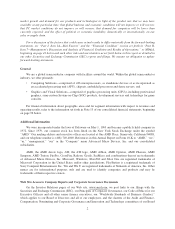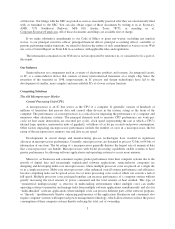AMD 2013 Annual Report Download - page 18
Download and view the complete annual report
Please find page 18 of the 2013 AMD annual report below. You can navigate through the pages in the report by either clicking on the pages listed below, or by using the keyword search tool below to find specific information within the annual report.Graphics and Visual Solutions segment. Five customers, including Hewlett-Packard Company, accounted for
approximately 58% of the net revenue attributable to our Computing Solutions segment. In addition, five
customers, including Hewlett-Packard, Microsoft and Sony, accounted for approximately 70% of the net revenue
attributable to our Graphics and Visual Solutions segment. A loss of any of these customers could have a
material adverse effect on our business.
Original Equipment Manufacturers
We focus on three types of OEMs: multi-nationals, selected regional accounts and target market customers.
Large multi-nationals and regional accounts are our core OEM customers. Our OEM customers include numerous
foreign and domestic manufacturers of servers and workstations, desktops, notebooks and PC motherboards.
Third-Party Distributors
Our authorized distributors resell to sub-distributors and mid-sized and smaller OEMs and ODMs.
Typically, distributors handle a wide variety of products, including those that compete with our products.
Distributors typically maintain an inventory of our products. In most instances, our agreements with distributors
protect their inventory of our products against price reductions and provide return rights with respect to any
product that we have removed from our price book that is not more than 12 months older than the manufacturing
code date. In addition, some agreements with our distributors may contain standard stock rotation provisions
permitting limited levels of product returns.
AIB Manufacturers and System Integrators
We strive to establish and broaden our relationships with AIB manufacturers. We offer component-level
graphics and chipset products to AIB manufacturers who in turn build and sell board-level products using our
technology to system integrators, or SIs, and to retail buyers. Our agreements with AIBs protect their inventory
of our products against price reductions. We also sell directly to our SI customers. SIs typically sell from
positions of regional or product-based strength in the market. They usually operate on short design cycles and
can respond quickly with new technologies. SIs often use discrete graphics solutions as a means to differentiate
their products and add value to their customers.
Competition
Generally, the IC industry is intensely competitive. Products typically compete on product quality, power
consumption (including battery life), reliability, speed, performance, size (or form factor), cost, selling price,
adherence to industry standards (and the creation of open industry standards), software and hardware
compatibility and stability, brand recognition, timely product introductions and availability. Technological
advances in the industry result in frequent product introductions, regular price reductions, short product life
cycles and increased product capabilities that may result in significant performance improvements. Our ability to
compete depends on our ability to develop, introduce and sell new products or enhanced versions of existing
products on a timely basis and at competitive prices, while reducing our costs.
Competition in the Microprocessor Market
Intel Corporation has dominated the market for microprocessors for many years. Intel’s market share,
margins and significant financial resources enable it to market its products aggressively, to target our customers
and our channel partners with special incentives and to discipline customers who do business with us. These
aggressive activities have in the past and are likely in the future to result in lower unit sales and a lower average
selling price for our products and adversely affect our margins and profitability.
10
























